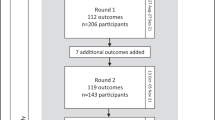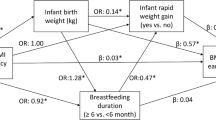Abstract
Overweight/obese women are more likely to deliver newborns that also have a predisposition to store excessive amounts of fat since the early infancy period. Two evidence-based cycles are considered on the explanation of the maternal–child life-course approach for obesity prevention. The ‘maternal’ cycle indicates that pre-pregnancy overweight primiparous women are more likely to gain excessive weight during gestation and to retain excessive weight postpartum. The ‘offspring’ cycle indicates that newborns of pre-pregnancy overweight/obese women are more likely themselves to store excessive body fat starting very early on in life. The social ecological model (SEM) has been adopted as the framework needed to guide obesity prevention initiatives. The SEM considers the complex interrelationship among highly interconnected systems embedded within each other and having the individual on its inner most. Recommendations to women should include prevention of overweight/obesity prenatally, to attain adequate gestational weight and to lose the weight normally gained as part of the physiological response to pregnancy in the postpartum period. For the ‘offspring’ the aims should be to promote optimal breastfeeding and complementary feeding practices, and to foster physical activity and adequate dietary habits. Well-coordinated inter-sectorial national obesity prevention programs built upon the life-course framework foundation requires in-depth early life systems analyses driven by the SEM.
This is a preview of subscription content, access via your institution
Access options
Subscribe to this journal
We are sorry, but there is no personal subscription option available for your country.
Buy this article
- Purchase on Springer Link
- Instant access to full article PDF
Prices may be subject to local taxes which are calculated during checkout

Similar content being viewed by others
References
Flegal KM, Carroll MD, Kit BK, Ogden CL . Prevalence of obesity and trends in the distribution of body mass index among US adults, 1999–2010. JAMA 2012; 307: 491–497.
Ogden CL, Carroll MD, Kit BK, Flegal KM . Prevalence of obesity and trends in body mass index among US children and adolescents, 1999–2010. JAMA 2012; 307: 483–490.
IOM (Institute of Medicine). Weight Gain during Pregnancy: Reexamining the Guidelines. The National Academies Press: Washington, DC, USA.
Nader PR, Huang TT, Gahagan S, Kumanyika S, Hammond RA, Christoffel KK . Next steps in obesity prevention: altering early life systems to support healthy parents, infants, and toddlers. Child Obes 2012; 8: 195–204.
Pérez-Escamilla R, Bermúdez O . Early life nutrition disparities: where the problem begins? Adv Nutr 2012; 3: 71–72.
Kac G, Benício MH, Velásquez-Meléndez G, Valente JG, Struchiner CJ . Gestational weight gain and pre-pregnancy weight influence postpartum weight retention in a cohort of Brazilian women. J Nutr 2004; 134: 661–666.
Taveras EM, Gillman MW, Kleinman K, Rich-Edwards JW, Rifas-Shiman SL . Racial/ethnic differences in early-life risk factors for childhood obesity. Pediatrics 2010; 125: 686–695.
Bronfenbrenner U . The Ecology of Human Development. Harvard University Press: Cambridge, MA, USA, 1979.
Story M, Kaphingst KM, Robinson-O′Brien R, Glanz K . Creating healthy food and eating environments: policy and environmental approaches. Annu Rev Public Health 2008; 29: 253–272.
Pérez-Escamilla R, Damio G, Himmelgreen D, González A, Segura-Pérez S, Bermúdez-Millán A . Translating knowledge into community nutrition programs: lessons learned from the Connecticut Family Nutrition Program for Infants, Toddlers, and Children. Recent Res Dev Nutr 2002; 5: 69–90.
Vaag AA, Grunnet LG, Arora GP, Brøns C . The thrifty phenotype hypothesis revisited. Diabetologia 2012; 55: 2085–2088.
Acknowledgements
RP-E has received grant support from National Institutes of Health and the Centers for Disease Control and Prevention. GK is a research fellow from the Brazilian National Council for Scientific and Technological Development (CNPq). The publication was supported in part by the Government of Aruba, the Obetech Obesity Research Center, the Pan American Health Organization and the Pan American Health and Education Foundation. This paper is derived from the workshop ‘Education for childhood obesity prevention: A life-course approach’, co-organized by the Panamerican Health Organization (PAHO) and the Panamerican Health and Education Foundation (PAHEF), and held on 14 June 2012 in Aruba, as part of the II Pan-American Conference on Childhood Obesity (http://www.paco.aw/).
Author information
Authors and Affiliations
Corresponding author
Ethics declarations
Competing interests
The authors declare no conflict of interest.
Rights and permissions
About this article
Cite this article
Pérez-Escamilla, R., Kac, G. Childhood obesity prevention: a life-course framework. Int J Obes Supp 3 (Suppl 1), S3–S5 (2013). https://doi.org/10.1038/ijosup.2013.2
Published:
Issue Date:
DOI: https://doi.org/10.1038/ijosup.2013.2
Keywords
This article is cited by
-
Pregnancy weight gain in twin gestations and maternal and child health outcomes at 5 years
International Journal of Obesity (2021)
-
Obesity Prevention: Strategies and Challenges in Latin America
Current Obesity Reports (2018)
-
The Role of WIC in Obesity Prevention
Current Pediatrics Reports (2017)
-
Characterizing a “Big Data” Cohort of Over 200,000 Low-Income U.S. Infants and Children for Obesity Research: The ADVANCE Early Life Cohort
Maternal and Child Health Journal (2017)
-
Food, health, and complexity: towards a conceptual understanding to guide collaborative public health action
BMC Public Health (2016)



